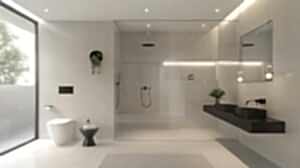
Updating a bathroom can be an exciting project filled with many possibilities, and one stylish and functional upgrade to think about is the creation of a wet room. Wet rooms are waterproof, open plan areas that contribute to the bathroom’s character and convenience. Designed to make any bathroom feel like a spa retreat, a wet room is a fully waterproof area where the shower is integrated into the wall or ceiling, often without any traditional shower tray or enclosure, and the drain is integrated into the floor. The floor will slope inwards slightly towards the drain to ensure efficient drainage.
Why consider a wet room?
The installation of a wet room in the bathroom brings a lot of features and benefits that can contribute positively to you or your customer’s home.
Maximising the space: Ideal for large bathrooms with extra space to use up or making smaller bathrooms seem more spacious, a wet room makes every inch of a bathroom count. The open-plan design removes the need for bulky enclosures, helping to increase the space available.
Improving accessibility: With no steps and a level floor, open-space wet rooms reduce the risk of tripping and have much better accessibility for children, the elderly and anyone with mobility impairments.
Easy cleaning & maintenance: With no enclosures or trays and fewer edges and joints, wet rooms are very easy to clean. You’ll just need to clean and wipe down the walls and floor with appropriate cleaners and ensure proper waterproofing and drainage.
Increasing property value: With wet rooms being a popular choice for modern bathrooms due to their ease of installation and use, they can positively impact a property’s value for potential buyers.
Creating your wet room
First, assess the space you have available and what the layout of the wet room will be. Decide on the placement of the shower, drainage and other fixtures. Make sure to avoid placing certain fixtures in the shower’s splash zone, such as toilets and bathroom furniture.
Waterproofing
Making sure the wet room is completely waterproof is the most vital step of the installation. If the area isn’t properly waterproofed and leaks or moisture gets through to the walls and floors, it can cause a lot of damage. Waterproofing, also known as tanking, is essential for your wet room’s durability and longevity. You can apply a liquid tanking system or waterproof membrane to the walls and floor, making sure to properly seal all joints and edges with waterproof sealant. Make sure to let waterproofing layers cure properly before moving onto your next steps.
Drainage
Installing proper drainage is also important to keep your wet room functioning properly and avoiding any water damage or pooling. The floor in a wet room should be slightly sloped towards the drain and the drain itself needs to be connected to the home’s overall plumbing system. There are several drain designs to choose from including central drains and linear drains.
Walls
For the walls in your wet room, you can install waterproof wall panels or tiles. Wall panels are durable, easy to install and clean, and require no grouting. Tiles have more versatile and unique design options but will need proper sealing and grouting to avoid leaks. You can install tile backer board behind the tiles to ensure the wet room is watertight and they will contribute to thermal insulation too.
Floors
The flooring of the wet room needs to be completely waterproof and slip resistant too to avoid falls and accidents. Use tiles such as textured porcelain or ceramic and ensure they’re properly sealed. You can even install underfloor heating in the wet room to add a touch of luxury and help the water to evaporate quicker.
Shower
Choosing the right type of shower fixture for your wet room is an exciting part of the project. Opt for rain showers or shower towers for a luxurious, spa aesthetic, wall showers for a traditional look, or mixed showers that offer both options! For wet rooms with more space available you can even install a bath or shower bath too.
Ventilation
Every bathroom requires ventilation to allow moisture to escape and prevent the build-up of condensation and damp. Sometimes just opening a window isn’t enough, so installing a wall or floor extractor fan is a good idea.
Lighting, accessories & extras
Now that you’ve got the basics down, including your flooring, panelling and backer board, drainage and shower, you can start bringing the space together with the perfect finishing touches. Create some modern mood lighting with multi-coloured waterproof lighting strips or add a heated towel rail for extra comfort. Optimise storage in the wet room with built-in wall shelves, recessed wall niches or wall-hung cabinets.
When choosing fixtures and accessories make sure to match (or mismatch!) colours and finishes such as chrome, matt black or brass – whatever your overall bathroom design calls for. Match your shower head with your bathroom taps and towel rail to tie the room together.
Creating your wet room will require planning, time and resources, but the finished result will leave you (or your customer) with a transformed haven that you can step into on a daily basis. By focusing your efforts on efficient drainage, waterproofing and high-quality materials and fixtures, you can create a functional and stylish wet room to elevate your bathroom to the next level.